 This paper is one of a series of studies that investigates the rock art of the Majes Rock Art Style (MRAS) in southern Peru. This time I focus on petroglyphs of long, pecked stripes that have been animated by the prehistoric Majes People. I now argue that those Animated Stripes and many other typical MRAS images (discussed earlier by me; see my bibliography), including another icon (the “Majes Spitter”, which is the subject of my next study) created the Toro Muerto Anomaly, which – unfortunately – is either unknown or neglected by archaeologists busy in the Majes Valley.
This paper is one of a series of studies that investigates the rock art of the Majes Rock Art Style (MRAS) in southern Peru. This time I focus on petroglyphs of long, pecked stripes that have been animated by the prehistoric Majes People. I now argue that those Animated Stripes and many other typical MRAS images (discussed earlier by me; see my bibliography), including another icon (the “Majes Spitter”, which is the subject of my next study) created the Toro Muerto Anomaly, which – unfortunately – is either unknown or neglected by archaeologists busy in the Majes Valley.
By Maarten van Hoek
*
*
Animated Abstracts
in Majes Rock Art, Peru
*
Maarten van Hoek
Introduction
First of all, Majes Rock Art is not only found in the Majes Valley of southern Peru, but in a much larger area between the rivers Caravelí in the west of the Department of Arequipa to and inclusive of the drainage of the Río Vítor in the east (Figure 1). In that area the characteristic Majes Rock Art Style (MRAS) sets the area apart from all other (neighbouring) rock art regions of (southern) Peru. The MRAS is characterised by specific petroglyphs of anthropomorphic figures, felines, birds, snakes and camelids of different layouts and dating from several eras.
Figure 1. Map showing the distribution of the Majes Rock Art Style in western Arequipa between the Río Caravelí and the Río Vítor. Only a very small selection of sites is shown. Map © by Maarten van Hoek, based on the map © by OpenStreetMap – Contributors.
Click any illustration to see an enlargement
While having surveyed the rock art of the area in the field and studied its petroglyphs at home for more than twenty years now, I started to discern an anomaly in the distribution of several iconic images within the MRAS. Although the imagery found within the MRAS is indeed rather uniform, it proves that one specific area stood out for having many images that are either overrepresented in, or are (more or less) exclusive for the Central Majes Valley; the limited area that I consider to have been the cradle of the prehistoric Majes Culture (thus I reject the existence of the purported “Siguas-1 Culture”; once introduced by Joerg Haeberli [2002]).
For instance, although petroglyphs of felines occur throughout the area of the MRAS (and of course beyond), the Central Majes Valley has an astonishing overabundance of feline images (Van Hoek 2021a). Similarly, the iconic Majes “Dancers”, the enigmatic Majes “Feathered Homunculus”, the Majes “Rectangular Birds” and the Majes “Spitters” occur (with often only an extremely small number of exceptions) only at Toro Muerto (TM) and Alto de Pitis (AP), the two major rock art sites in the Central Majes Valley (Van Hoek 2018 and more [see my bibliography]). Also the often impressively large zigzags, stripes (Figure 2 and cover-photo) and zigzag-stripe combinations are exclusive for only the Central Majes Valley; the great majority occurring at Toro Muerto. A special variation of the stripe is the subject of this study.
Figure 2. Boulder at Toro Muerto with two stripes. Photograph © by Maarten van Hoek.
*
Stripes
A stripe is an (almost invariably) vertically arranged, straight (yet sometimes slightly curved) “groove” that has been (very) superficially pecked out, not to form a thin line, but a straight and rather broad band (Figure 2). Horizontally arranged stripes are very rare in the MRAS. It seems that several stripes started as a long outlined “rectangle” that was later fully pecked (the outlining lines still visible in several cases). A panel may have only one stripe, or up to at least eight parallel running stripes (or perhaps more; I have not seen every panel at Toro Muerto). Their width varies between a couple of centimetres to a rare example of 57 cm in width (on Boulder TM-Nw-037; see cover-photo), the average roughly ranging between 10 and 20 cm (as in the examples in Figure 2). Stripes usually are very long, but shorter and even rather small, rectangular examples also occur. At Toro Muerto stripes are often found in (in my opinion premeditated) combinations with similarly executed large zigzagging grooves or wide bands, and with short lines, dots and pecked discs, but also often (though then of smaller sizes) with Majes “Dancers”. Other types of petroglyphs do not seem to represent associations.
Although I – subjectively – regard stripes to be abstract figures, it seems that several abstract MRAS-petroglyphs – thus including stripes – may represent animated abstracts, and thus these images can no longer be regarded to essentially depict abstract forms. Unfortunately, because of mainly being vertically arranged, the lower parts of several stripes are often covered by desert sand, thus possibly hiding (further) animating elements (as is the case in Figure 2). Moreover, some (especially broad) stripes seem to superimpose earlier features. For all these reasons, the examples described in this study only represent a selection of stripes and animated abstracts.
*
Animated Abstracts
Although all the observations in this study only involve my subjective interpretations (which are thus hard to prove), I regard several biomorphic petroglyphs of the Central Majes Valley to originally represent abstract figures, which have been transformed into anthropomorphic or zoomorphic images (possibly even phytomorphic; see Van Hoek 2022a: 12; Fig. 13), that possibly were executed at the same time by the same hand, or perhaps – which is sometimes rather likely – at a later date by someone-else. Animated abstracts in the MRAS involve for instance petroglyphs of (possible) solar images, at least two of which have been anthropomorphised by simultaneously drawing (or adding at a later date?) facial features (one example is found at Caravelí [Van Hoek 2022b: Fig. 15]; one at Toro Muerto).
Also in some cases serpentines and zigzags have (later?!) been transformed into Majes “Dancers”, for example at Toro Muerto and at Alto de Pitis. For instance, a serpentine groove on Boulder TM-Bb-065 seems to have been transformed into an ill-formed Majes “Dancer” by adding (a?) a few often shorter grooves (Figure 3A), while at Alto de Pitis two adjacent zigzags have been transformed into Majes “Dancers” (Figure 3B). Exclusively found at Toro Muerto are rare zigzags that clearly have had animal heads (added?). In other cases long, thin lines seem to have a snake’s heads (added?) at one (upper) end (for example on Boulder TM-Bw-004).
Figure 3. Petroglyphs from A: Toro Muerto; B: Alto de Pitis. The lines “a” in Figure 3.A2 may have been added later. Photographs and drawing © by Maarten van Hoek.
Moreover, some stripes (but also some thin lines) feature all sorts of small appendages that emerge from the top end and/or the lower end, that sometimes look like arms and/or feet. For instance, on Panel TM-Ba-002B a thin stripe features horn-like extensions from both the top and bottom of the stripe, while a stripe on Boulder TM-Bb-007 has “horns” at the top, but also three short splayed lines from the lower end (is the central line a phallus?). A stripe on Boulder TM-Bb-049 has two bird-like feet and two parallel serpentine lines emerging from the bottom part (Figure 4A), a very short stripe on Boulder TM-Ba-019 has “curved legs” at its top end.
Figure 4. A: Boulder TM-Bb-049 (the arrow indicates the position of the stripe illustrated in Figure 6D); B: Boulder TM-Cw-016. Both boulders occur at Toro Muerto, and feature a possibly animated stripe. Photographs © by Maarten van Hoek.
Boulder TM-Bc-034 has two stripes, one (2 in Figure 2; 105 cm in height) having two short parallel lines (incised later?) emerging from its top end (a headdress? – H in Figure 2) and two lines (arms? – A in Figure 2), one continuing as a zigzag running downwards parallel to the stripe, while a short groove emerges from one of its sides (a phallus? – P in Figure 2). On Panel TM-Bd-001B are again two stripes, one (see Figure 6B) having short, curved legs (?) with a short thin line in between; again, a possible indication of a (human) phallus?
Also enigmatic are the many instances where stripes seem to have been animated by adding zoomorphic features. For instance, one stripe (on Boulder TM-Cw-016) has two thin grooves emerging from its upper end (arms or even wings?), while a long, thin (added?) line continues from that spot, apparently ending in a possible bird’s head (of a condor?) (see Figure 4B). Another exceptional example – on Boulder TM-Be-003 – involves a horizontally arranged stripe that (judging by the two hooves at each of the two short legs) seems to have been transformed into an excessively long camelid of about 70 cm in length, yet not showing an animal head.
An intriguing (possible) animation seems to have been executed on Panel TM-Da-071A. Two vertical stripes (which can be interpreted as two massively long legs) are joined at their upper ends by a horizontal stripe, one end having a possible zoomorphic tail, while the right-hand end may have a simple, circular (animal?) head. Finally, the imagery at Toro Muerto (and to a lesser extent Alto de Pitis) is special for the many stripes that are intentionally topped by a bird image hovering directly over the stripe; the bird-on-pole configuration.
*
Anthropomorphised Stripes
It now appears that stripes have sometimes been transformed into anthropomorphic figures as well, although there often remains an element of doubt, like with the six excessively long Majes “Dancers” on Panel TM-Be-022A that might all have started as stripes. Also the example at Boulder TM-Da-054 (Figure 5F) is enigmatic and thus dubious. Yet, a few examples unambiguously prove that stripes have intentionally been anthropomorphised.
Figure 5. A: TM-Nw-052; B: TM-Nw-039; C: TM-Ns-020; D: TM-NNx-026; E: TM-Bd-017; F: Boulder TM-Da-054; G: TM-Dx-027. Drawings © by Maarten van Hoek.
Before discussing those examples of anthropomorphised stripes, I must nevertheless emphasise that all my interpretations are subjective, and may thus be incorrect. This especially concerns the group of very short “stripes” that often are broader than long, thus forming pecked rectangles or even squares. They may be related to the “standard” stripe having two short lines from its top, like the example on Panel TM-Nw-052 (Figure 4A) and on a few more panels. Several of those very short, pecked areas also have two short, straight lines emerging from the upper corners (as if representing arms?), while others have similar lines from the lower corners (Figure 4B and C). In some instances those lines are curved outwards, giving the impression of feet (Figure 4D and E). They may be related to (animated) stripes, but I have no idea what such images really symbolise or represent.
However, a possible answer may be given by several standard stripes that seem to have been animated in often a very special way. Some longer, standard stripes also have such arm-like extensions from the top end, while others not only have two curled feet-like lines at the lower end, but also a short, vertically arranged line between those two purported feet, for instance the 90 cm high example on Boulder TM-Dx-025 (Figure 6C). The whole configuration thus gives the impression of an (elongated) body of an anthropomorph with feet and a male sexual organ. What is (intentionally?) missing are the head and arms. On the enormous Boulder TM-NNx-001 at Sector-X at Toro Muerto is a large stripe (1 in Figure 7) that is about 100 cm in height, with curved feet (?), a short, thin line in between (a phallus?), while from the upper end emerge four lines; one very short one (a neck?), two longer, curved lines (arms?) and a broader, vertical line (off-centre) touching one dot-and-circle motif of a row of six examples (included to represent a head?). On the same panel is a similar, yet outlined example filled with one serpentine line, and yet another, simpler example (resp. 2 and 3 in Figure 7). Example 3 is outlined, yet drawn as if fully pecked by James Posso Sánchez in his 2020-book (151; Fig. 22).
Figure 6. A: TM-Aa-044; B: TM-Bd-001; C: TM-Dx-025; D: TM-Dx-025; E: TM-Bb-007; F: TM-Nw-051; G: TM-NW-046; H: TM-Bc-028. Drawings © by Maarten van Hoek.
Figure 7. Boulder TM-NNx-001 at Sector-X – Toro Muerto. Photograph © by James Posso; drawing © by Maarten van Hoek, based on his photograph.
On Boulder TM-Bc-028 at Toro Muerto is a long stripe that seems to have short legs and feet, while a short, horizontal line emerging from the purported genital area may again represent a phallus (Figure 6H). More importantly, from the top end emerge two short lines (arms?) that seem to uplift an animal; symbolising some kind of animal-veneration, or even a sacrifice? A similar, more informative example is found on Boulder TM-Nw-051. It depicts a long stripe with two short, arm-like extensions that are clearly holding a small, two-legged animal aloft (Figure 6F). Unfortunately, its lower end is covered by desert sand, possibly concealing illustrative details. Nearby, on heavily vandalised Boulder TM-Nw-046 is a similar example showing two possible legs or feet, although arms seem to be missing (Figure 6G). On severely damaged Boulder TM-Cc-002 is a stripe having a U-shaped groove at its top that seems to uplift a very large, internally decorated quadruped, while a smaller stripe – having a similar U-shaped groove – seems to carry an anthropomorphic figure (possibly a Majes “Dancer”). These last two examples offer proof that the short, vertical lines of the U-shape do not represent legs of a quadruped.
*
Two Clear-Cut Cases
In my opinion it is almost certain that several stripes have intentionally been animated by (much later?) adding anthropomorphic elements, like feet, arms, male organs, and – in rare cases – heads (at least in one case with facial elements). Because in most cases the picture is not complete or clear-cut, there always will remain an element of doubt. Besides the possible anthropomorphised example on Boulder TM-Bc-028 (see Figure 6H) this study will now present only two more, clear-cut cases (both from Toro Muerto) that will now be discussed and illustrated in more detail.
*
Boulder TM-Dx-027
The first example is found on Boulder TM-Dx-027, located in a southern section of Toro Muerto. One of the petroglyphs on this boulder (a figure of about 40 cm in height) clearly represents a stripe with two splayed (added?) legs (Figure 8; see also Figure 5G). The left arm ends in a hand with (three?) digits, while the other “arm” seems to have intentionally been extended, apparently in order to touch the genital area of the figure (it is unclear whether a phallus has been drawn). Its rectangular head (without facial features) is topped by two vertically arranged lines (similar to several other [animated?] stripes that do not have a head, like Stripe 2 in Figure 2). This example seems to express some sexual content (added later?), but exactly what kind of (fertility?) symbolism is shown by this image, is completely obscure to me. The other petroglyphs on this panel do not offer any further clue, as they seem not to be related (which is often the case in the MRAS).
Figure 8. Boulder TM-Dx-027 at Toro Muerto, showing an anthropomorphised stripe (for a drawing see Figure 5G). I regard the white code on this boulder to be a form of (unintended) vandalism! Photographs © by Maarten van Hoek.
*
Panel TM-Be-054B
Much further north at Toro Muerto is Panel TM-Be-054B featuring three anthropomorphic figures (Figure 9: 1 to 3) and one fully pecked quadruped (4 in Figure 9). Anthropomorph 3 is small but “normally” proportioned, has two legs (and feet?), two raised arms showing digits and a small circular head with possibly facial features (the panel is rather rough, making it difficult to interpret details clearly and to distinguish natural features from anthropic markings). Fully pecked Anthropomorph 2 is somewhat larger and seems to carry a fully pecked, circular object (a “Trophy” Head? See Van Hoek 2023 for a lengthy (illustrated) discussion about such figures). Its triangular head is topped by one long “plume”. However, it is the much larger Anthropomorph 1 that is of special interest in this study.
Figure 9. Panel TM-Be-054B at Toro Muerto, showing an anthropomorphised stripe. Photograph and drawing © by Maarten van Hoek.
Anthropomorph 1 on Panel TM-Be-054B clearly is an intentionally anthropomorphised stripe. There is no question about that. The body (the original stripe) is too excessively long to represent the body of a standard (MRAS) anthropomorph. It has two short legs (ending in feet with possibly up to four digits), while in between those legs there just possibly may be an indication of (male?) gender. I now wonder why anthropomorphised stripes at Toro Muerto only seem to have [possible] male organs? Although I have no proof, I guess that there is a fertility-related explanation.
From the very top of the figure emerge two raised and flexed arms (each ending in three or four digits). Between the raised arms is an outlined head, possibly showing a mouth and two eyes (the rough surface inhibits proper inspection). Importantly, especially the arms and the head are relatively far too small to harmonise with the length of the body (the stripe). For that reason I think that they have been added, most likely at a later stage. But whether this happened in the same cultural context or by the same hand is completely enigmatic to me.
*
Some Observations
Within the scope of this study it must be mentioned that there are also serpentine- or zigzag petroglyphs that have been animated by adding animal heads (sometimes “spitting”) to the zigzags or serpentine grooves. Earlier I labelled those configurations the “Serpentine Groove with Multiple Heads”. Those extremely rare animated grooves occur only at Toro Muerto (however, see Figure 3B), where among the probably thousands of zigzag-serpentine petroglyphs no more than four instances of the “Serpentine Groove with Multiple Heads” have – so far – been recorded on only three boulders: Boulder TM-Bf-001, Boulder TM-Aa-019A and Boulder TM-Aa-038B. Surprisingly those three boulders are found (relatively) very close together at the very edge of the NE section of the Toro Muerto boulder field. Those images also confirm the anomaly of Toro Muerto within the MRAS.
Finally, it must also be emphasised that there are petroglyphs in the MRAS that just possibly might have started as a stripe and that (possibly by joining two or more stripes) have been anthropomorphised by adding a head and/or arms and legs. An example might concern the “hidden” Majes “Dancer” on Boulder TM-Bf-017 at Toro Muerto (Van Hoek 2022c: Fig. 7). Also the anthropomorphic figure on Panel TM-NNx-028 just possibly may have started as one or more stripes (Figure 10), but it will need specialist research to ascertain my tentative suggestion. After all, I may be wrong.
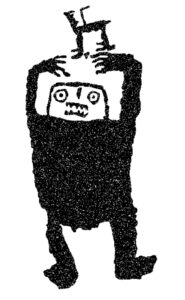 Figure 10. Petroglyphs on Panel TM-NNx-028 at Sector-X (Toro Muerto). Drawing © by Maarten van Hoek, based on an illustration published by “Lubetima Te Informa” (2019).
Figure 10. Petroglyphs on Panel TM-NNx-028 at Sector-X (Toro Muerto). Drawing © by Maarten van Hoek, based on an illustration published by “Lubetima Te Informa” (2019).
*
Conclusions
Abstract motifs that have allegedly been animated, occur at many rock art sites in the Desert Andes. For instance, anthropomorphised solar petroglyphs occur at Toro Muerto; at the remote rock art site of Cíceras in the Majes Drainage (fully discussed in Van Hoek 2021b: Fig. 4); at Caravelí [Van Hoek 2022b: Fig. 15]; at Turulaca in southern Peru; at Canicora along the Pacific coast near Ilo, also in southern Peru; further north at Checta and Apan in the Chillón Valley; Cerro Mulato in the Reque Valley and Alto de la Guitarra in the Virú Drainage, all those sites together covering a roughly south-north stretch of coastal strip of about 1500 km.
In sharp contrast, animated stripes – like the ones discussed in this study – only seem to occur in the Central Majes Valley, roughly in a south-north section of the valley of only 12 km. In my opinion there is not a shred of doubt that petroglyphs of stripes in the MRAS have intentionally been anthropomorphised, even though only a few petroglyphs offer proof of my claim. This exclusivity is remarkable, even though a (rather thin) “stripe” with two flanking zigzags (looking like the characteristic Majes strip-zigzag combination) has been recorded at Turulaca in the far south of Peru (located about 245 km SE of Toro Muerto). But whether this Turulaca petroglyph represents an instance of cultural diffusion is not at all certain. Parallel evolution may never be ruled out when discussing distribution of specific motifs and/or images across the globe (for an example see Van Hoek 2020a; 2024).
Although I never counted the stripes of the MRAS, I estimate that there are several hundreds of examples in the rock art sites of the Central Majes Valley. It is therefore surprising and enigmatic to see that only a very small fraction seems to have been animated and that, moreover, only a handful seem to have unequivocally been anthropomorphised. In many other cases there often is an element of doubt whether indeed animation had been intended. Importantly, animated stripes only seem to occur at Toro Muerto; they seem to be absent at Alto de Pitis. Although examples are found distributed across the whole length of the five kilometres long Toro Muerto boulder field, there seems to be a slight preference for the northern part.
Although stripes are found in combination with several other types of images at Toro Muerto, definite associations are often not present. However, stripes are definitely found intimately associated with zigzags, with Majes “Dancers”, and – when petroglyphs depict “Quadrupeds-on-Pole (see Figures 6F, G and H) or Birds-on-Pole – the pole is often a [rather short] stripe. However, because of the extremely small number of clearly anthropomorphised stripes, it is impossible to distinguish a pattern of corelation between images (compare Figures 8 and 9).
There is, however, one other definite “association” and that concerns the fact that – up to now (2024) – anthropomorphised stripes have only been found at Toro Muerto. Therefore, so far animated stripes only occur within the rock art repertoire of the Central Majes Valley, which again emphasises the unique position of the Central Majes Valley. This exclusive status is also confirmed by the (almost) unique presence of the iconic Majes “Dancer”, the enigmatic Majes “Feathered Homunculus”, the (possibly Wari-influenced) Majes “Rectangular Bird” and the Majes “Spitter”.
The occurrence of so many exclusive symbols in a restricted, relatively small area means that the Majes Valley is a cultural anomaly within the MRAS. This anomaly should be taken into account by every (bio)archaeologist and rock art researcher when excavating or surveying sites in this area. Every scientific excavation in the Central Majes Valley must be done by professionals that are fully aware of the graphical content of the MRAS in general, but especially of the deviant graphical content of the rock art found in this part of the Majes drainage. One should thus be cautious to publish unfounded opinions and/or alleged “facts”.
I now argue that this unique status of the imagery of the Central Majes Valley should be acknowledged and taken into account by all researchers of the Central Majes Valley, whether it concerns academic (bio)archaeologists or non-academic scientists like me. When publishing “proof” (like the drawings in this study), it is highly desirable to also publish photographs of the panel along with the drawing (see for instance Figures 3, 4, 7, 8 and 9 in this study) to be able to verify the correctness of the drawings. If no photograph is provided in the publication, it is only scientifically and ethically correct to share such relevant photos when asked for.
In this respect, at least two academic bio-archaeologists once published two “photographs” of petroglyphs from the Majes Valley (“photo a” from Toro Muerto; “photo b” from Alto de Pitis) that are demonstrably incorrect (they are in fact not even photos, but incorrect tracings; see the insets in Figures 11 and 12 of the Addendum), as well as their incorrect rock art related “conclusions” regarding Majes rock art (Scaffidi and Tung 2020). I published several papers proving their “photographs” and their rock art related “conclusions” to be incorrect (for instance Van Hoek 2020b – Updated 2023) and asked the authors several times for the original photos to be shared with me. Their silence lasts up to the date of publication of this study (thus over three years now). Even the editor of their paper – Dr. Judy Turner – refused to provide me with the original photos. My personal comments regarding this most un-scientific practice can be read in my personal webpage. For my original photos regarding this issue, also see the Addendum.
Fortunately, I am not the only one who exposes and criticises errors frequently occurring in scientific publications. In his sharp, yet excellent critiques regarding numerous scientific publications involving all sorts of flaws, errors, frauds and deceptions by scientists of all eras, Jona Lendering (2012: 267) writes (freely translated by me and put in the context of this study): “Archaeologists must take their audience seriously, otherwise the public will not take archaeology seriously.”. He also states (2012: 271; again freely translated) that scientists can no longer just publish information. They should in any case also enter into an active dialogue, and not only publish correct information, but also contest incorrect information.
Concluding: published information should never be incorrect, and – above all – authors who still publish false information (like Scaffidi and Tung 2020: Fig. 3; and their incorrect [rock art related] conclusions), whether fabricated intentionally or not, should have the decency and integrity to acknowledge their errors in public when exposed. Scaffidi and Tung never did enter into any dialogue with me; they ignored all my emails since 2012. Therefore, they should read Lendering’s book. In fact every scientist and researcher should. Why? Because the negative nature of the (serious) problems described by Lendering will intensify enormously because of the internet, because of “social” media and – above all – because of AI. Apparently many people think that we do not have to use our own capacities, our own “intelligence” anymore. People (not me) think people need AI. They are wrong. Use of AI will result in (serious) abuse and even more serious problems, world-wide. Please, do no longer take all published information for granted! Be critical and – above all – publicly acknowledge any published error from your side!
*
Acknowledgements
I am grateful to James Posso from Arequipa, Peru, for his kind permission to use and publish his (graphical) information (in this study it concerns the photo in Figure 7). Of course I am much indebted to my wife Elles, who assisted me while surveying Toro Muerto and Alto de Pitis several times (and numerous other rock art sites), as well because of her ongoing support at home.
*
Addendum
Figure 11. The “Trophy” Head Carrier on Boulder TM-Da-032 at Toro Muerto, Majes Valley. It is beyond any doubt that the “tracing” (orange inset above) of this petroglyph by Scaffidi and Tung (2020: Fig. 3a) is factually incorrect. The white lines in their Fig. 3 are explained by them (in their otherwise irrelevant 2022-Erratum) to represent “tracings” that they derived from their D-Stretched photo of the original photo (which I was never allowed to see). However, their 2019-D-Stretched photo-(a) is severely blurred, and as a consequence they created incorrect “tracings”. And still Scaffidi and Tung decided to publish those incorrect “tracings”! My unaltered photo also convincingly proves that there is no weapon (which is also confirmed by academic archaeologist Justin Jennings). Photograph (only enhanced by me) and drawing © by Maarten van Hoek; my © drawing based on the “photo” by Scaffidi and Tung 2020: Fig. 3).
Figure 12. Panel AP3-065A at Alto de Pitis. It is beyond any doubt that the “tracing” of this petroglyph by Scaffidi and Tung (2020: Fig. 3b; Inset “A” above) is demonstrably incorrect (also confirmed by Justin Jennings). Again, the white lines in their Fig. 3 are explained by them (2022-Erratum) to represent “tracings” derived from their D-Stretched photo. It is inexplicable that their D-Stretched photo-(b) is faultless, while their “tracings” do not match their D-Stretched photo at all. And yet Scaffidi and Tung decided to publish their incorrect “tracings”! Again there is no weapon. Photograph (only enhanced by me) and drawing © by Maarten van Hoek; drawing “A” based on Scaffidi and Tung 2020: Fig. 3b (more info in Van Hoek 2023).
Figure 13. A and B: The incorrect tracings of petroglyphs from Toro Muerto and Alto de Pitis, published by academic bio-archaeologists Beth Scaffidi and Tiffiny Tung (2020: Fig. 3), compared with the factual layout of the same petroglyphs (C and D), as interpreted by me, based on the photos of Figures 11 and 12. All drawings © by Maarten van Hoek, A and B based on Fig. 3 by Scaffidi and Tung (2020). More most relevant information in Van Hoek 2020-2023.
*
Erratum
In my 2023-update (Van Hoek 2020-2023: Fig. 4), in which I contested Fig. 3 and the rock art related conclusions of the 2020-Scaffidi-Tung-paper, I erroneously mentioned that the photograph of Figure 12 above concerned Boulder TM-Da-032 (thus located at Toro Muerto), while the correct label should read Panel AP3-065A (thus in fact the panel is located at Alto de Pitis). My error has been corrected in this study (but perhaps not in every publication). My apologies for any confusion.
*
References
Haeberli, J. 2002. Siguas 1: a newly identified Early Horizon Culture, Department of Arequipa, Peru. Textile Society of America Symposium Proceedings. PDF.
Lendering, J. 2012. De Klad in de Klassieken. Athenaeum – Polak & Van Gennip. Amsterdam (URL); Lendering’s personal website URL.
Posso Sánchez, J. 2020. Toro Muerto – Rumbo a Patrimonio Mundial. Universidad Nacional de San Augustin. Arequipa, Perú (URL).
Scaffidi, B. and T. Tung. 2020. Endemic violence in a pre-Hispanic Andean community: A bioarchaeological study of cranial trauma from the Majes Valley, Peru. American Journal of Physical Anthropology. Vol. 2020; pp. 1 – 24. PDF available at Academia.
Van Hoek. M. 2018. Formative Period Rock Art in Arequipa, Peru. An up-dated analysis of the rock art from Caravelí to Vítor. Oisterwijk, Holland. PDF available at ResearchGate.
Van Hoek, M. 2020a. A Case of Diffusion or of Parallel Creativity? INORA. Vol. 88; pp. 21 – 23. PDF available at ResearchGate.
Van Hoek, M. 2020/2023. False Information Concerning Majes Rock Art, Peru. In: TRACCE – Online Rock Art Bulletin. Italy. Revised Version November 2023. The PDF of this Revised Version is available at ResearchGate.
Van Hoek. M. 2021a. Contextualising the Unexpected Plethora of Feline Petroglyphs in the Majes Valley, Peru. In: TRACCE – Online Rock Art Bulletin, Italy.
Van Hoek, M. 2021b. The Cíceras “Carcancha-Bird” Petroglyphs, Majes, Peru. In: TRACCE – Online Rock Art Bulletin, Italy.
Van Hoek, M. 2022a. The Case of Boulder AP1-001, Alto de Pitis, Majes Valley, Southern Peru. In TRACCE – Online Rock Art Bulletin, Italy.
Van Hoek, M. 2022b. The Book of the Río Caravelí Petroglyphs, Peru – Further Analyses. Oisterwijk, Holland. PDF only available at ResearchGate.
Van Hoek, M. 2022c. The Majes “Dancer” – Analysing an Enigmatic Icon. Oisterwijk, Holland. Book only available as PDF at ResearchGate.
Van Hoek. M. 2023. “Trophy” Heads in the Rock Art of North and South America”. Book available as PDF only at ResearchGate.
Van Hoek, M. 2024. Imaoun – Morocco. Cross-Examining the Venus Cross in the Rock Art of Morocco and Beyond. In: TRACCE – Online Rock Art Bulletin, Italy.
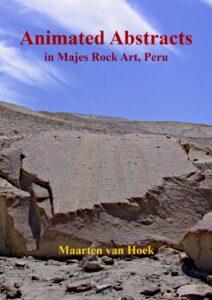



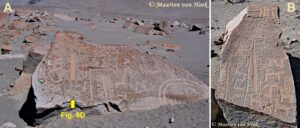
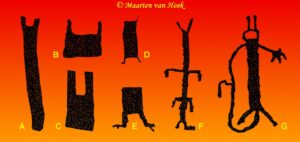
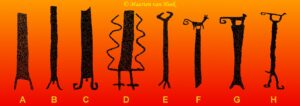
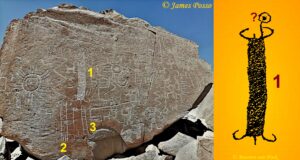
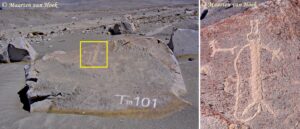
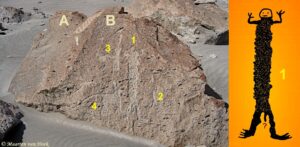
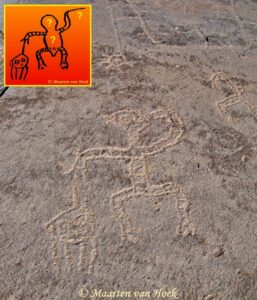
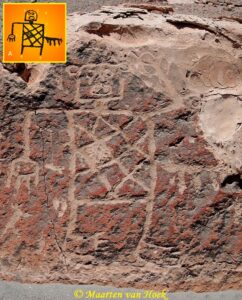
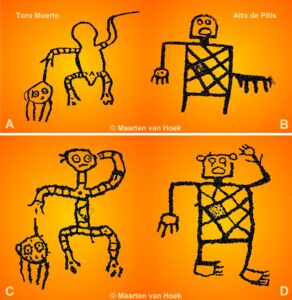














Leave a Reply